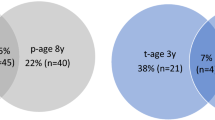Abstract
Behaviors characteristic of ADHD are common among preschool children, and as such, their clinical significance is oftentimes difficult to ascertain. Thus a focus on impairment is essential in determining the clinical significance of these behaviors. In order to explore the impact of impairment criteria on rates of diagnoses in inattentive/hyperactive children aged 36 through 60-months-old, we first developed, and psychometrically evaluated, the Children’s Problem Checklist (CPC) which was designed to assess psychosocial impairment associated with ADHD in a community sample of preschoolers (n = 394), and found its reliability and validity to be acceptable. We then examined the impact of the inclusion of various CPC-determined impairment criteria, over and above symptom criteria measured by the ADHD-RS-IV, using various cut points ranging from the 75th to 90th percentile of our community sample. This reduced the number of children meeting criteria for ADHD by 46–77%. These findings are discussed in terms of the importance of using impairment criteria, rather than just severity of inattention, impulsivity and hyperactivity, when diagnosing ADHD in preschool children.
Similar content being viewed by others
References
American Psychiatric Association (2000). Diagnostic and statistical manual of mental disorders: DSM-IV-TR (4th ed.). Washington, DC: American Psychiatric Association (text revision).
Bird, H. R., Canino, G., Rubio-Stipec, M., Gould, M. S., Ribera, J., Sesman, M., et al. (1988). Estimates of the prevalence of childhood maladjustment in a community survey in Puerto Rico. Archives of General Psychiatry, 45, 1120–1126.
Breton, J., Bergeron, L., Valla, J. P., Berthiaume, C., Gaudet, N., Lambert, J., et al. (1999). Quebec child mental health survey: Prevalence of DSM-III-R mental health disorders. Journal of Child Psychology and Psychiatry, 40, 375–384.
Campbell, S. B. (2002). Behavior problems in preschool children: Clinical and developmental issues (2nd ed.). New York: Guilford.
Campbell, S., Ewing, L., Breaux, A., & Szumowski, E. (1986). Parent-referred problem three-year olds: Follow-up at school entry. Journal of Child Psychology and Psychiatry, 27, 473–488.
Costello, E. J., Costello, A. J., Edelbrook, C., Burns, B. J., Dulcan, M. K., Brent, D., et al. (1988). Psychiatric Disorders in pediatric primary care. Archives of General Psychiatry, 45, 1107–1116.
DuPaul, G. J., Power, T. J., Anastopoulos, A. D., & Reid, R. (1998). ADHD Rating Scale-IV: Checklists, norms, and clinical interpretations. New York: Guilford.
Fabiano, G. A., Pelham, W. B., Waschbusch, D. A., Gnagy, E. M., Lahey, B. B., Chronis, A. M., et al. (2006). A practical measure of impairment: Psychometric properties of the impairment rating scale in samples of children with attention deficit hyperactivity disorder and two school-based samples. Journal of Clinical Child and Adolescent Psychology, 35, 369–385.
Faraone, S. V., Sergeant, J., Gillberg, C., & Biederman, J. (2003). The worldwide prevalence of ADHD: Is it an American Condition. World Psychiatry, 2, 104–113.
Gordon, M., Antshel, K., Faraone, S., Barkley, R., Lewandowski, L., Hudziak, J. J., et al. (2006). Symptoms versus impairment: The case for respecting DSM-IV’s criterion D. Journal of Attention Disorders, 9, 465–475.
Graetz, B. W., Sawyer, M. G., Hazell, P. L., Arney, F., & Baghurst, P. (2001). Validity of DSM-IV ADHD subtypes in a nationally representative sample of Australian children and adolescents. Journal of the American Academy of Child and Adolescent Psychiatry, 40, 1410–1417.
Healey, D. M., & Rucklidge, J. J. (2006). An investigation into the relationship among ADHD, creativity, and neuropsychological functioning in children. Child Neuropsychology, 12, 421–438.
Loughran, S. B. (2003). Agreement and stability of teacher rating scales for assessing ADHD in preschoolers. Early Childhood Education Journal, 30, 247–253.
McClellan, J. M., & Speltz, M. L. (2003). Psychiatric diagnosis in preschool children. Journal of the American Academy of Child and Adolescent Psychiatry, 42, 127–128.
McGoey, K. E., DuPaul, G. J., Haley, E., & Shelton, T. L. (2007). Parent and teacher ratings of Attention Deficit/Hyperactivity Disorder in Preschool: The ADHD Ratings Scale-IV Preschool Version. Journal of Psychopathology and Behavioral Assessment, 29, 269–276.
Nakao, K., & Treas, J. (1994). Updating occupational prestige and socioeconomic scores: How the new measures measure up. Sociological Methodology, 24, 1–72.
Romano, E., Tremblay, R. E., Vitaro, F., Zoccolillo, M., & Pagani, L. (2001). Prevalence of psychiatric diagnoses and the role of perceived impairment: Findings from an adolescent community sample. Journal of the American Academy of Child & Adolescent Psychiatry, 42, 451–462.
Rowland, A. S., Umbach, D. M., Catoe, K. E., Stallone, L., Long, S., Rabiner, D., et al. (2001). Studying the epdemiology of attention-deficit hyperactivity disorder: screening method and pilot results. Canadian Journal of Psychiatry, 46, 931–940.
Simonoff, E., Pickels, A., Meyer, J. M., Silberg, J. L., Males, H. H., Loeber, R., et al. (1997). The Virginia twin study of adolescent behavioral development: influences of age, sex, and impairment on rates of disorder. Archives of General Psychiatry, 54, 801–808.
Sonuga-Barke, E. J. S., Auerback, J., Campbell, S. B., Daley, D., & Thompson, M. (2005). Varieties of preschool hyperactivity: multiple pathways from risk to disorder. Developmental Science, 8, 141–150.
Wolraich, M. L., Feurer, I. D., Hannah, J. N., Baumgaertel, A., & Pinnock, T. Y. (1998). Obtaining systematic teacher reports of disruptive behavior disorders utilizing DSM-IV. Journal of Abnormal Child Psychology, 26, 141–152.
Zito, J. M., Safer, D. J., dosReis, S., Gardner, J. F., Boles, M., & Lynch, F. (2000). Trends in prescribing of psychotropic medications to preschoolers. Journal of the American Medical Association, 283, 1059–1060.
Author information
Authors and Affiliations
Corresponding author
Rights and permissions
About this article
Cite this article
Healey, D.M., Miller, C.J., Castelli, K.L. et al. The Impact of Impairment Criteria on Rates of ADHD Diagnoses in Preschoolers. J Abnorm Child Psychol 36, 771–778 (2008). https://doi.org/10.1007/s10802-007-9209-1
Received:
Accepted:
Published:
Issue Date:
DOI: https://doi.org/10.1007/s10802-007-9209-1




